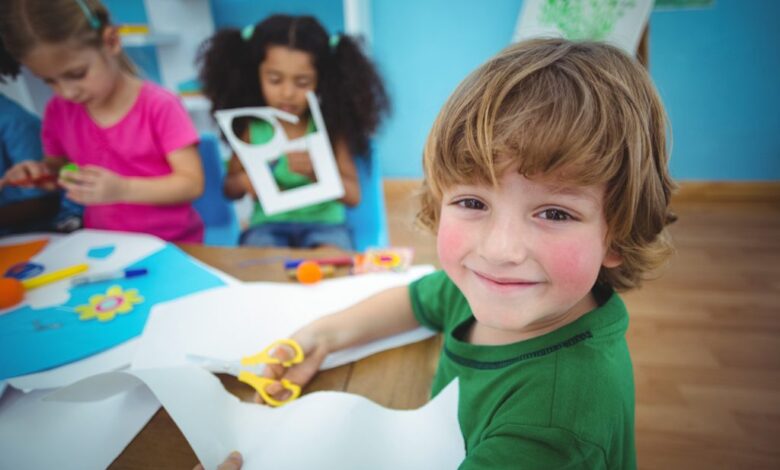Fostering Creativity in Children Through Art and Play:

Fostering Creativity in Children Through Art and Play:Creativity is a crucial component of childhood development. It shapes how individuals think, solve problems, and express themselves. Fostering creativity is essential not just for personal growth but also for societal progress. This article explores the multifaceted importance of nurturing creativity. From historical perspectives to modern applications, you’ll discover why creativity matters and how it impacts education, professional success, and innovation. Dive in to understand the profound effects of creativity and how to cultivate it in various aspects of life.
The Natural Creativity of Kids:
Children are inherently creative, exhibiting a limitless capability for creativity creativeness creativity creativeness and innovation. This natural creativity is clear in their potential to create whole worlds from easy toys, transform regular items into something first-rate, and develop particular answers to troubles. Understanding the character of children’s creativity can assist adults nurture and sustain this crucial trait all through their lives.
Boundless Imagination
From a young age, kids exhibit boundless creativity. They have interact in imaginative play, create tales, and envision fantastical eventualities that go beyond the boundaries of reality. This ingenious ability isn’t best a source of pleasure but additionally, a fundamental way children make feel of the arena around them. Imaginative play permits youngsters to experiment with distinctive roles, explore feelings, and broaden cognitive skills.
Uninhibited Expression
Children are specific themselves freely and without the limitations that regularly hinder adults. This uninhibited expression manifests in their art, storytelling, and play. They are not afraid to make errors or explore unconventional thoughts. This freedom to test is essential for creative increase, allowing children to broaden unique perspectives and solutions.
Curiosity and Exploration
Curiosity drives children’s creativity. Their natural inclination to discover, ask questions, and try to find out new stories fuels their creative endeavors. This interest ends in experimentation and discovery, as children study through trials and blunders. Encouraging this curiosity is important for retaining their innovative spirit, because it lays the foundation for lifelong mastering and innovation.
Problem-Solving Skills
Children regularly provide you with imaginative answers to troubles. Their potential to assume outside the container and technique challenges with clean views is a trademark of their creativity. This hassle-fixing capacity is nurtured through play and exploration, in which they learn to navigate obstacles and devise creative strategies. Supporting this hassle-solving technique allows youngsters to increase resilience and adaptability.
The Role of Environment
The surroundings perform a widespread function in fostering kid’s natural creativity. Providing stimulating and supportive surroundings, wealthy in possibilities for exploration and expression, is key. Access to numerous materials, open-ended toys, and innovative activities encourages children to test and innovate. Additionally, a nurturing atmosphere wherein errors are visible as learning opportunities promote confidence and creative risk-taking.
The Impact of Technology
In the contemporary virtual age, the ra can each beautify and restrict kids’ creativity. While virtual tools offer new avenues for creative expression and getting to know, immoderate screen time and passive intake can stifle creativity. It’s vital to strike a stability, using technology to supplement traditional innovative sports and ensuring that children have ample possibilities for hands-on exploration and play.
Encouraging Lifelong Creativity
To sustain children’s natural creativity into adulthood, it is essential to nurture it constantly. This involves encouraging creative interests, presenting possibilities for inventive play, and fostering a growth attitude. By valuing creativity and assisting kids’ innovative efforts, we can help them keep their innovative spark and apply it to all regions of life.
In the end, the natural creativity of youngsters is a powerful force that shapes their development and potential. By expertise and nurturing this creativity, we can assist youngsters grow into revolutionary and resilient individuals, capable of contributing creatively to society.
- Introduction to Creativity
- Historical Perspectives on Creativity
- The Role of Creativity in Personal Development
- Creativity in Education: Benefits and Strategies
- Impact of Creativity on Professional Success
- Creativity and Problem-Solving: Real-World Applications
- Technological Advances and Creative Innovation
- Overcoming Barriers to Creativity
- Cultivating a Creative Mindset
- Conclusion: The Future of Creativity in Society
Historical Perspectives on Creativity:
Creativity has been an imperative a part of human life since the sunrise of civilization. It has driven cultural evolution, technological advancements, and artistic expression. Examining the historical perspectives on creativity gives valuable insights into the way it has been perceived, nurtured, and applied across different durations and cultures. This section explores the evolution of creativity from historic instances to the contemporary generation.
Ancient Civilizations
In historic civilizations, creativity turned into in general related to survival and the realistic desires of society. Early people confirmed great ingenuity in developing gear, developing art, and devising answers to environmental challenges. For example, the invention of the wheel and the development of agricultural techniques have been pivotal in shaping human societies. The ancient Egyptians, recognized for their architectural marvels like the pyramids, showcased their innovative prowess via engineering, artwork, and written language, reflecting an advanced expertise in the sector.
Classical Antiquity
During Classical Antiquity, creativity was often viewed as a divine gift. In Ancient Greece, creativity changed into related to the Muses, the goddesses of proposal for literature, technological know-how, and the humanities. Philosophers like Plato and Aristotle debated the character of creativity, with Plato thinking about it as a form of divine insanity and Aristotle viewing it as a skill that would evolve. This length saw a flourishing of literature, philosophy, and the arts, with figures like Homer, Socrates, and Sophocles making lasting contributions to the Western cultural background.
The Renaissance
The Renaissance marked a length of remarkable creative output and intellectual rebirth. Creativity was celebrated as a hallmark of genius, and people like Leonardo da Vinci and Michelangelo epitomized the Renaissance best of the polymath, excelling in more than one discipline. This era noticed sizeable advancements in art, technological know-how, and literature, pushed with the aid of a renewed hobby in classical antiquity and a focal point on human capacity. The invention of the printing press through Johannes Gutenberg revolutionized the dissemination of knowledge, in addition to fueling creative and intellectual pursuit pursuitgreatly
The Enlightenment
The Enlightenment emphasized cause, logic, and medical inquiry, however, it additionally valued creativity as a method of advancing understanding and enhancing society. Thinkers like Immanuel Kant and Voltaire championed the power of human intellect and creativeness. This duration witnessed extensive advancements in literature, track, and the humanities, with composers like Mozart and Beethoven, and writers like Goethe and Rousseau, exemplifying the creative spirit of the time. The Enlightenment laid the basis for modern scientific and intellectual ideas, highlighting the interaction between creativity and cause.
The Industrial Revolution
The Industrial Revolution brought profound modifications in society, driven by with pursuits greatly with greatly with the aid of technological innovation and creative problem-fixing. Creativity become an increasing number of identified as a key factor in commercial and medical progress. Inventors like Thomas Edison and innovators like the Wright brothers established the transformative strength of innovative questioning, leading to improvements in transportation, communication, and production. This period also noticed the rise of recent inventive actions, along with Impressionism, which challenged traditional norms and explored new varieties of expression.
The Twentieth Century and Beyond
The twentieth century witnessed an explosion of creativity across various domains, from science and era to the humanities and popular lifestyle. The speedy tempo of alternate and the rise of recent media and verbal exchange technologies created unprecedented possibilities for creative expression. The virtual age, in particular, has revolutionized how creativity is produced, shared, and eaten up. The creation of the net, social media, and digital equipment has democratized creativity, permitting individuals from numerous backgrounds to contribute to the worldwide creative landscape.
Cultural Variations in Creativity
Throughout history, special cultures have placed varying levels of emphasis on creativity. In some societies, creativity has been surprisingly valued and included in everyday lifestyles, while in ogreatly others greatly greater and greatly greater constrained via social norms and traditions. For example, Eastern cultures, in particular in Japan and China, have a wealthy lifestyle of creativity in arts like calligraphy, poetry, and martial arts, often emphasizing concord and stability. In evaluation, Western cultures have regularly celebrated individualism and innovation, main to a wonderful approach to creative expression.
The Evolution of Creative Theories
Theories approximately creativity have evolved, reflecting converting understandings of toughts and societal needs. Early theories frequently linked creativity to divine thought or innate understanding. In the twentieth century, psychological and cognitive procedures began to find out creativity as a complex interaction of personality tendencies, cognitive tactics, and environmental elements. The paintings of psychologists like J.P. Guilford and Mihaly Csikszentmihalyi have been instrumental in developing present-day theories of creativity, highlighting the characteristic of divergent questioning and the concept of “go along with the glide.”
In stop, ancient views on creativity reveal its profound and enduring effect on human development and manner of lifestyles. By studying how creativity has been understood and valued all through history, we gain a deeper appreciation for its role in shaping the arena and its potential to stress destiny improvement. Creativity isn’t always the handiest relic of the beyond; it’s miles a dynamic pressure that keeps persuading and inspiring humanity.
The Role of Creativity in Personal Development:
Creativity plays a pivotal function in personal improvement, influencing various factors of a character’s increase and well-being. It enhances cognitive competencies, emotional intelligence, social capabilities, and usual life pleasure. By fostering creativity, individuals can release their full capability and lead extra enjoyable lives.
Stress Relief and Mental Health
Engaging in innovative activities presents a healing outlet for pressure and tension. The act of creating can be meditative, permitting people to be cognizant cognizance of their minds and reap a state of flow. This immersion in innovative endeavors reduces strain ranges, promotes rest, and improves usual mental health. Creativity additionally affords an experience of feat and motive, contributing to effective shallowness and emotional well-being.
Social Skills and Communication
Creativity enhances social capabilities through selling collaboration, verbal exchange, and empathy. Participating in organization creative sports, such as theater, song ensembles, or collaborative art tasks, encourages individuals to paint collectively, share ideas, and admire numerous views. These collaborative surround fostersters powerful communication, teamwork, and the potential to navigate social interactions with self-belief.
Personal Identity and Self-Expression
Creative interests permit people to discover and define their identities. Through creative expression, human beings can speak their values, beliefs, and reviews, growing a stronger feeling of self. This self-expression fosters authenticity and individuality, permitting individuals to understand and embody their particular features.
Lifelong Learning and Adaptability
Creativity promotes an attitude of lifelong gaining knowledge of and adaptability. Creative individuals are open to new experiences, curious about the sector, and willing to take dangers. This openness to getting to know and boom enhances adaptability, permitting individuals to navigate life’s challenges and uncertainties with resilience and innovation. Creativity also encourages a proactive approach to hassle-solving, as individuals seek out creative solutions to triumph over boundaries.
Professional and Academic Success
Creativity is a treasured asset in each instructional and expert setting. In education, innovative wondering complements getting to know by using encouraging students to explore topics intensively, think severely, and develop revolutionary answers. In the expert realm, creativity drives innovation, hassle-fixing, and the potential to conform to changing environments. Employers increasingly fee innovative abilities, spotting their significance in driving enterprise achievement and fostering a dynamic place of job tradition.
Cultivating Creativity Throughout Life
To maximize the advantages of creativity in non-public improvement, it’s miles important to domesticate it at some point in lifestyles. This involves growing environments that help creative expression, providing possibilities for creative exploration, and inspiring a boom mindset. Educational systems, places of work, and groups can play a huge function in nurturing creativity through valuing and selling creative endeavors.
In conclusion, creativity is a fundamental aspect of personal improvement, enriching cognitive, emotional, and social growth. By fostering creativity, individuals can decorate their problem-solving abilities, emotional intelligence, and typical well-being, main to a greater gratifying and hit lifestyle.
Historical Perspectives on Creativity:
Creativity has been using pressure at Forbes at some stage in human history, shaping cultures, advancing civilizations, and fueling development. Understanding the historical perspectives on creativity affords valuable insights into its evolution and its enduring significance in numerous contexts. This phase explores how creativity has been perceived and valued across specific eras and cultures.
Ancient Civilizations
In historic civilizations, creativity became carefully linked to survival and the sensible needs of society. Early people used creative questioning to increase tools, assemble shelters, and find food. This ingenuity laid the inspiration for the development of complex societies. Ancient Egypt, for instance, showcased immense creativity in its architecture, artwork, and written language, with the construction of the pypyramid’syramids status as a testament to their modern engineering and creative abilities.
Classical Antiquity
During the Classical Antiquity length, creativity began to be seen as a divine gift. In Ancient Greece, creativity was regularly associated with the Muses, the goddesses of suggestion for literature, technological know-how, and the humanities. Philosophers like Plato and Aristotle debated the nature of creativity, with Plato viewing it as a form of divine insanity and Aristotle spotting it as an ability that might be cultivated. This period saw the flourishing of literature, philosophy, and the arts, with extraordinary figures like Homer, Socrates, and Sophocles contributing to the cultural and historical past of the Western international.
The Renaissance
The Renaissance was a period of rebirth and unprecedented creative output, marked by a renewed interest in the arts, science, and exploration. Creativity was celebrated and seen as a hallmark of genius. Figures like Leonardo da Vinci and Michelangelo epitomized the Renaissance ideal of the polymath, excelling in multiple fields and pushing the boundaries of what was possible. The invention of the printing press by Johannes Gutenberg revolutionized the dissemination of knowledge, further fueling creative and intellectual pursuits.
The Enlightenment
The Enlightenment period emphasized emphasis-emphasized motive, good judgment, and scientific inquiry, but it additionally valued creativity as a way of advancing understanding and improving society. Thinkers like Immanuel Kant and Voltaire championed the strength of human intellect and imagination. This generation saw large advancements in literature, track, and the humanities, with the works of Mozart, Beethoven, and the Romantic poets exemplifying the creative spirit of the time.
The Industrial Revolution
The Industrial Revolution brought profound adjustments in society, with technological innovation and creativity using monetary increase and remodeling regular lifestyles. Creativity was increasingly more recognized as a key aspect of business and scientific development. Inventors like Thomas Edison and innovators just like the Wright brothers have proven the transformative energy of creative wondering. The length also noticed the upward thrust of new inventive movements, together with Impressionism, which challenged conventional norms and explored new types of expression.
The 20th Century and Beyond
The twentieth century witnessed an explosion of creativity across numerous domain names, from technological know-how and generation to the arts and popular tradition. The fast pace of trade and the rise of recent media and conversation technologies created exceptional possibilities for creative expression. The virtual age, especially, has revolutionized how creativity is produced, shared, and fed on. The advent of the internet, social media, and digital gear have democratized creativity, allowing people from numerous backgrounds to contribute ma the worldwide innovative panorama.
Cultural Variations in Creativity
Throughout history, different cultures have placed varying degrees of emphasis on creativity. In some societies, creativity has been highly valued and integrated into daily life, while in others, it has been more constrained by social norms and traditions. For example, Eastern cultures, particularly in Japan and China, have a rich tradition of creativity in arts like calligraphy, poetry, and martial arts, often emphasizing harmony and balance. In contrast, Western cultures have often celebrated individualism and innovation, leading to a distinct approach to creative expression.
The Evolution of Creative Theories
Theories approximately creativity have evolved, reflecting changing understandings of the human mind and societal needs. Early theories regularly connected creativity to divine suggestion or innate skills. In the 20th century, psychological and cognitive tactics commenced to discover creativity as a complicated interaction of persona developments, cognitive techniques, and environmental elements. The paintings of psychologists like J.P. Guilford and Mihaly Csikszentmihalyi have been instrumental in developing contemporary theories of creativity, highlighting the position of divergent questioning and the concept of “flow.”
In conclusion, the ancient views on creativity screen its profound and enduring impact on human development and lifestyle. By examining how creativity has been understood and valued for the duration of records, we gain a deeper appreciation for its function in shaping the sector and its capacity to force future development.
Conclusion: The Timeless Significance of Creativity
Creativity has been a cornerstone of human development, using innovation, cultural expression, and societal development all through records. From historic civilizations to the digital age, the ability to suppose creatively has enabled humanity to overcome demanding situations, discover new frontiers, and increase our collective revel By information the ancient perspectives on creativity, we can appreciate its profound effect and they want to foster it in all factors of lifestyles. Embracing and nurturing creativity is crucial for non-public development, expert achievement, and the advancement of society. As we circulate ahead, encouraging innovative thinking and innovation will continue to be vital in addressing the complexities of our ever-evolving international.



